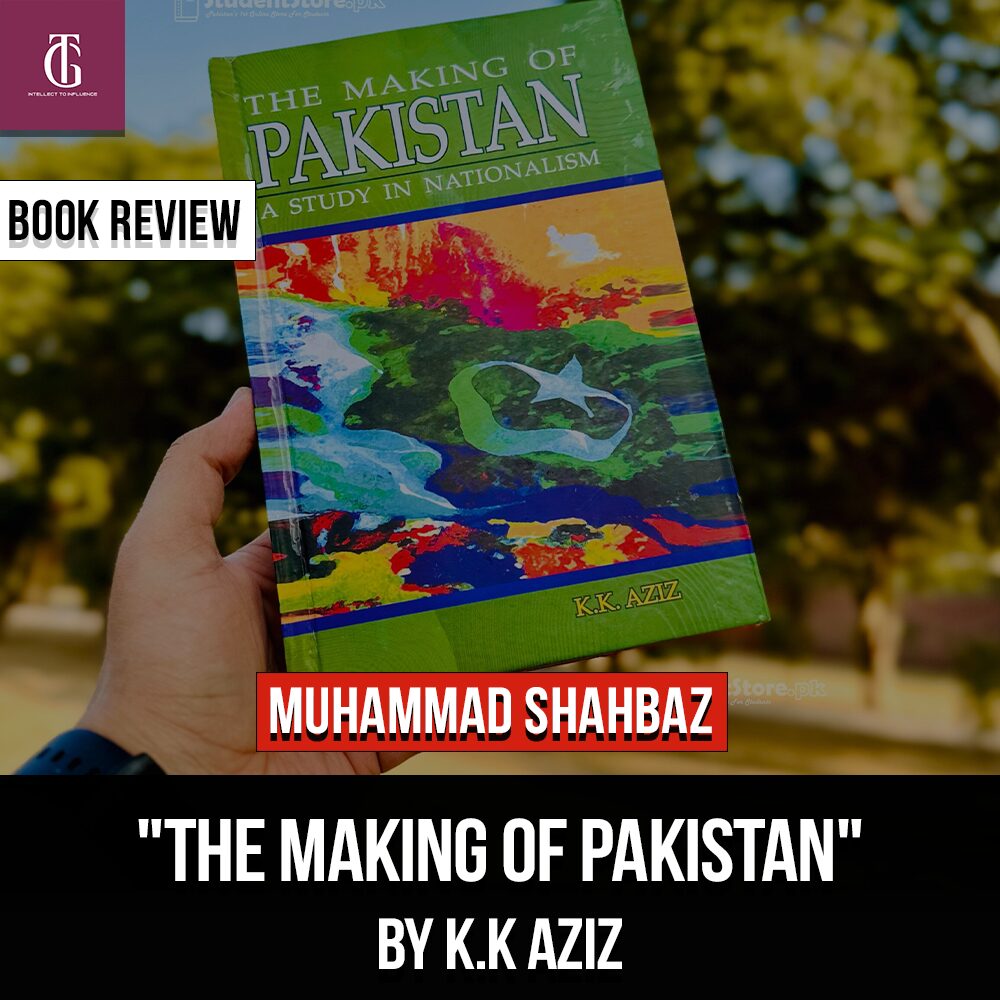
Khursheed Kamal Aziz, also known as K.K. Aziz, was a renowned Pakistani historian admired for his insightful analysis of Pakistan’s formation and historical development, influenced by his father’s scholarly background in Mughal history. Beyond his impressive credentials, Aziz was a courageous intellectual who fearlessly challenged established narratives, particularly regarding Pakistan’s history, making significant contributions to Pakistani historiography with his unwavering commitment to critical analysis. This review aims to examine Aziz’s influential publication, titled “The Making of Pakistan: A Study in Nationalism,” investigating his perspectives on the historical factors that contributed to the emergence of Pakistan.
The chapter “Historical factor 1” offers a thorough analysis of the Aligarh Movement and its effects on colonial India’s political order. With a detailed account that spans from the aftermath of the Mutiny of 1857 to the post-World War I era, it navigates through the complications of Muslim identity creation, political awakening, and relations with British imperial rule.
The protagonist of the subject matter is Sir Sayyid Ahmad Khan, whose pragmatic approach towards British colonialism and emphasis on education as a means of uplifting Muslims are extensively analysed. The chapter performs an excellent task of placing Khan’s pro-British views in the socio-political context of the day and illuminating his vision for the intellectual and cultural renewal of Muslims through projects such as the Muhammadan Anglo-Oriental College at Aligarh.
Furthermore, the chapter thoroughly illustrates the development of Muslim political awareness, from the early focus on educational progress and political seclusion to the All-India Muslim League’s founding and support for separate electorates. A deep analysis is conducted, emphasizing the importance that catalytic events like the Khilafat movement and the partition of Bengal sparked Muslim political activism and strengthening Hindu-Muslim unity against British authority. This chapter’s potential to convey the intricate details of intercommunal relations and the changing dynamics of Indian nationalism is one of its strongest points. The account efficiently draws attention to the intricate relationships that exist between religious, political, and socioeconomic elements, offering a sophisticated perspective of the difficulties and goals influencing Muslim politics in this century.
The chapter “Historical factor 2” carefully examines the multifaceted path that led to the formation of Pakistan, which was fueled by deeply ingrained communal conflicts and the colonial legacy of British India. It highlights the differences between Indian ambitions for self-governance and British colonial administration, starting with the Simon Commission in 1927. It then traces the changing relationships between Indian nationalist movements, especially the Congress and the Muslim League.
The absence of Indian representation in the Simon Commission led to a growing discontent among Indian politicians, especially the Congress, who saw it as a rejection for Indian voices in determining their own destiny. Following this, the Nehru Report amplified communal divisions by neglecting Muslim demands for separate electorates, bolstering Muslim opposition to Congress leadership and escalating the Hindu-Muslim split.
The failure of the Round Table Conferences to bring about reconciliation as tensions increased was predominantly the result of Congress’s insistence on its own definition of self-governance, which disregarded Muslim concerns. Despite being a significant step towards constitutional reform, the Government of India Act of 1935 did not alleviate Muslim concerns about Hindu supremacy and political consolidation.
It identifies the Congress victory in the 1937 provincial elections as a turning point, when Muslim fears were sparked by Congress’s unwillingness to offer any concessions to minority concerns along with the perception of Hindu supremacy. During this time, there were more recorded atrocities and communal tensions, which further alienated Muslims and increased their scepticism of Congress leadership.
The escalating divide between the two communities was made explicit by the Congress’s denial of peaceful coexistence with Muslims, its insistence on a centralized power structure, and its demand for a constituent assembly presided over by Hindus. Congress’s antipathy for minority rights and provincial autonomy fueled Muslims’ grievances.
The idea of Pakistan developed to take shape in the 1930s and 1940s, reaching its zenith with the 1940 Lahore Resolution. Despite early resistance, the British War Cabinet’s 1942 endorsement of the Pakistan principle represented an immense shift in colonial policy and the acknowledgment of Muslim nationalism as a powerful force.
Partition was inevitable, as evidenced by later events like as the Muslim League’s and Congress’s fruitless attempts at reconciliation and Muslims’ resounding victory in the 1945–1946 elections. Growing intercommunal violence and political impasse finally forced all sides to accept division, which resulted in the establishment of Pakistan and India as independent countries in 1947.
The chapter “Political factor” explores the complex interactions that shaped Muslim allegiance to the British colonial authorities in the early phases of Indian nationalism. It offers a sophisticated analysis of the factors that influence Muslim allegiance, putting particular emphasis on social, political, theological, and practical factors.
It illustrates the significant influence of individuals like as Sayyid Ahmed Khan in promoting Muslim allegiance to the British, based on the conviction that Muslims and the colonial authority had more in common than Hindu equivalents. This argument clarifies the intricate dynamics of Indian politics during the colonial era and is supported by views of British justice and the need for minority protections.
The chapter also examines the effects of imperial pride on the Muslim population, emphasizing how attitudes toward British rule were impacted by a feeling of historical entitlement and identity derived from earlier Muslim empires. In addition to encouraging opposition to British domination, this pride also fueled anti-democratic, which in turn fueled Muslim nationalism and the call for a separate state.
But the chapter also critically looks at nationalism that is Hindu-centric, showing how Hindu revival organizations and leaders inflamed anti-Muslim emotions, which furthered the growing gulf between Hindus and Muslims. Tensions increased as a result of the Congress’s unwillingness to recognize and value Muslim identity, which in turn fostered demands for separate state, Pakistan.
In-depth discussion of the complex interrelationships between nationalism, politics, and religion is provided in Chapter “The Religious factor”, which provides a sophisticated understanding of how these factors interact to form societies. The opening paragraph of the chapter asserts the great impact of religion on national consciousness, highlighting how it can be a potent factor for forming national identities and promoting social togetherness.
Religion has always been a fundamental element in the rise of nationalism, giving different national groups a sense of solidarity and pride. The chapter offers a wide range of instances that demonstrate how religion has influenced political movements and national identities in various places, including Greece, Scotland, and Italy.
Furthermore, it recognizes that, depending on historical circumstances, religion may be both a unifying and dividing force. It explores the subtleties of religion’s influence on national norms and character, highlighting the ways in which religious diversity has shaped societies and cultures.
It explores the birth of early Indian nationalism, which was frequently portrayed as mystical and having its roots in Hinduism. The integration of Hindu faith and political ideology is attributed to individuals like as Mahatma Gandhi, however conflicts between Muslim interests and Hindu-centric nationalism are also acknowledged.
It also examines the intellectual and practical obstacles that Islam and Hinduism present to India’s conception of nationalism. It investigates how traditional Islamic beliefs initially opposed territorial nationalism, whereas traditional Hindu caste distinctions impede national unity.A thorough examination of the symbiotic relationship between nationalism and culture is provided in Chapter “The Cultural factor”, which also illustrates the critical role that cultural components play in forming national identities and ideals.
Using historical examples from various places, such as Hellas and Rome, the chapter shows how culture has always existed before the idea of nationhood and its lasting impact on social cohesiveness and collective awareness. It explores the relationship between religion and culture in the Indian context, focusing on Indian Muslims who identified with a unique “Muslim culture” that assisted in the formation of Muslim nationalism.
It highlights the role of cultural bodies in promoting political unification and cultural renewal, using the Aligarh Movement as an illustration of how social uplift, education, language, and literature fostered national unity among Muslims in India. Education, literature, philosophy, and the arts also shaped national identity and ideology, highlighting the cultural divide between Muslims and Hindus and impeding attempts at unity. Language, particularly Urdu, played a significant role in cultural nationalism, exacerbating Hindu-Muslim tensions and contributing to the demand for Pakistan.
In Chapter “The Psychological factor” the psychological underpinnings of nationalism are explored. Patriotism is equated to a religious faith, with a focus on its ingrained nature, which is nourished by elements such as territory, culture, and history. Psychological aspects became crucial in the Indian setting, where nationalism’s historical and cultural foundations were relatively weak. This resulted in a battle of nationalisms that were waged mostly through myths, symbols, and hero worship.
Popular myths about India’s homogeneity and the martial prowess of Indian Muslims, combined with symbols such as flags and dress codes, contributed to driving a wedge between Hindus and Muslims and bolster their nationalistic passion. Muslim nationalism, driven by fear and insecurity within a Hindu-majority society, was further fueled by economic disparities and political marginalization, ultimately leading to the demand for a separate Muslim state, Pakistan.
The Two-Nation Theory, which Muhammad Ali Jinnah specifically promoted, is thoroughly examined in Chapter “The two-nation theory” along with its implications for the Indian subcontinent. Jinnah opposed the idea of a united India under a parliamentary system by arguing that Islam and Hinduism reflect different civilizations in India and calling for separate homelands to protect the identities and interests of Muslims and Hindus, respectively.
It explores the ideological and historical foundations of Muslim nationalism, following it back to the Muslims’ historical preservation of a distinct identity in India throughout British rule along with conflicts between Hindus and Muslims. Even though Nationalist Muslims made an effort to discourage separatism and support the Congress party’s ideal of a united India, the Congress’s inability to adequately address Muslim concerns escalated tensions and reinforced Muslims aspiration for the separate land.
Furthermore, the chapter explores the Congress’s attitude to the Muslim issue, which was marked by practices reminiscent of “divide-and-rule,” with the goal of fragmenting the Muslim population and maintaining Congress’s control. However, these attempts proved failed in persuading a sizable segment of the Muslim population to support Congress secularism.
Chapter “The Epilogue” provides a thorough overview of the obstacles and complications of Hindu-Muslim unity in India, including attempts in religious, cultural, and political arenas. It explores historical characters like Kabir and cultural connections in metropolitan areas like Lucknow and Delhi, exposing both the possibilities and limitations of such unity.
Furthermore, it examines the inevitability of the creation of Pakistan during British rule, attributing it to deep-seated Hindu-Muslim animosity compounded by political actions and Congress’ unwillingness to address Muslim issues. It also presents alternative proposals to partition, highlighting the lack of serious consideration by the Congress party and the consequences of its dismissal of Muslim demands.
It also explores the reasons for Muslim support for Pakistan, such as concerns about Hindu hegemony and conceptions of Pakistan as a safeguard to possible domination. The chapter investigates the practical consequences of the Two-Nation Theory and Jinnah’s argument for Pakistan’s demand, shedding light on the intellectual roots of partition in the complex political context of pre-Independence India.
“The Making of Pakistan” is a fascinating and well researched account that digs deeply into the historical events, cultural dynamics, and political complexity that culminated in the foundation of Pakistan.Whether you are a student or simply curious about the creation of Pakistan, this book will help you better comprehend one of the most important events in the region’s history. With its engaging account and thought-provoking analysis, “The Making of Pakistan” is a must-read for everyone interested in understanding the complexity of South Asia’s past and present.

Muhammad Shahbaz
Muhammad Shahbaz, a student from School of Politics and International Relations Quaid e Azam University Islamabad.





